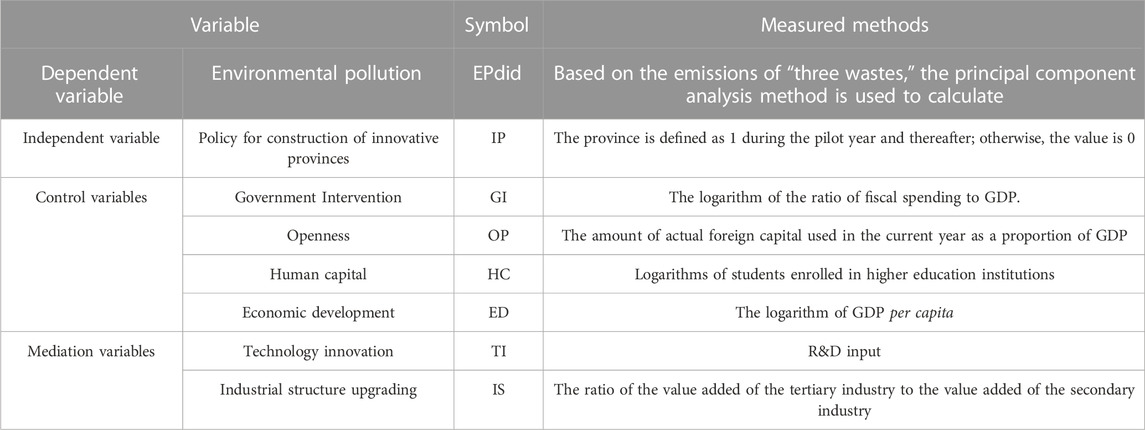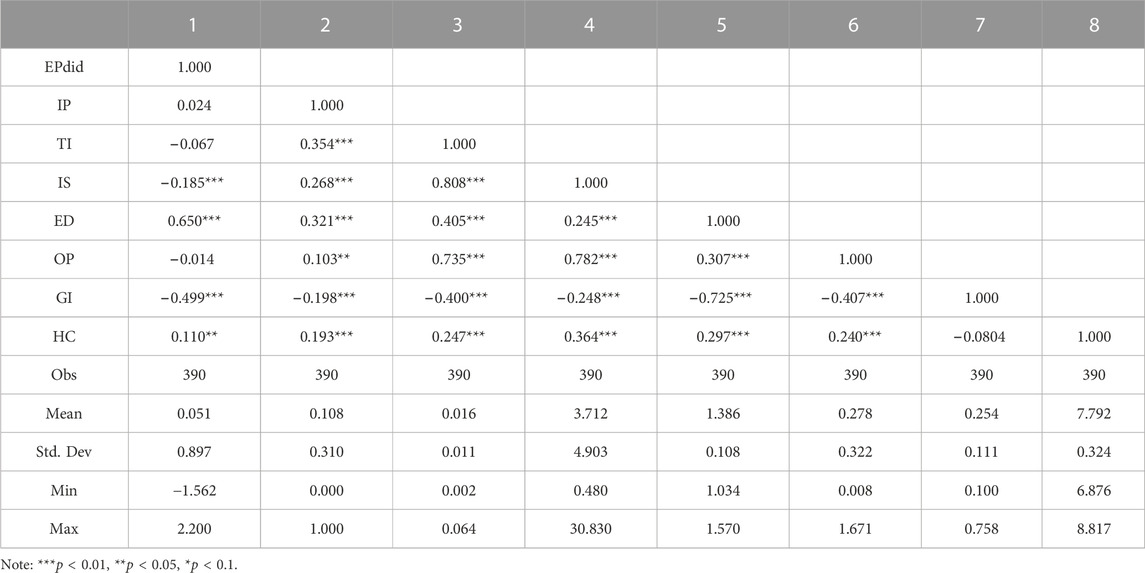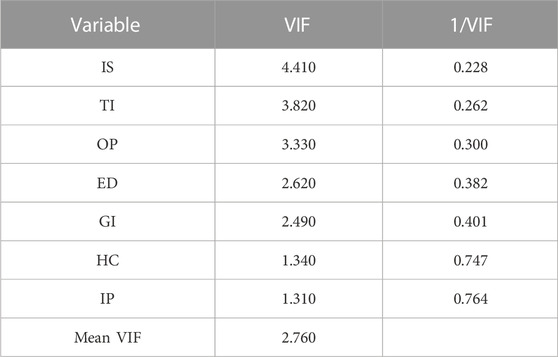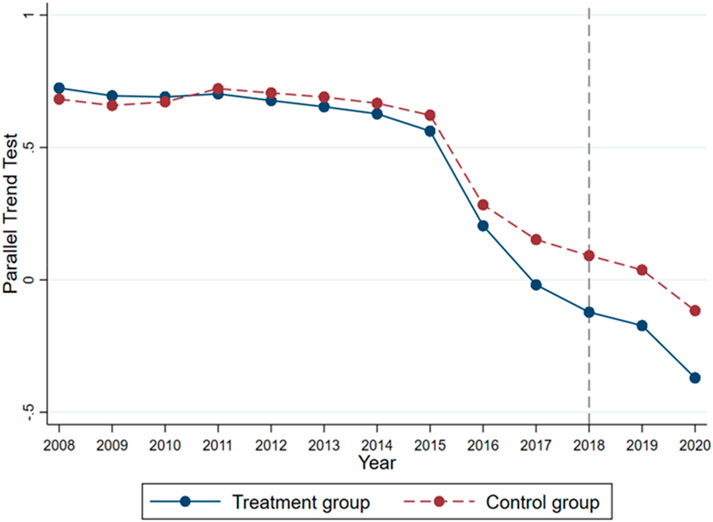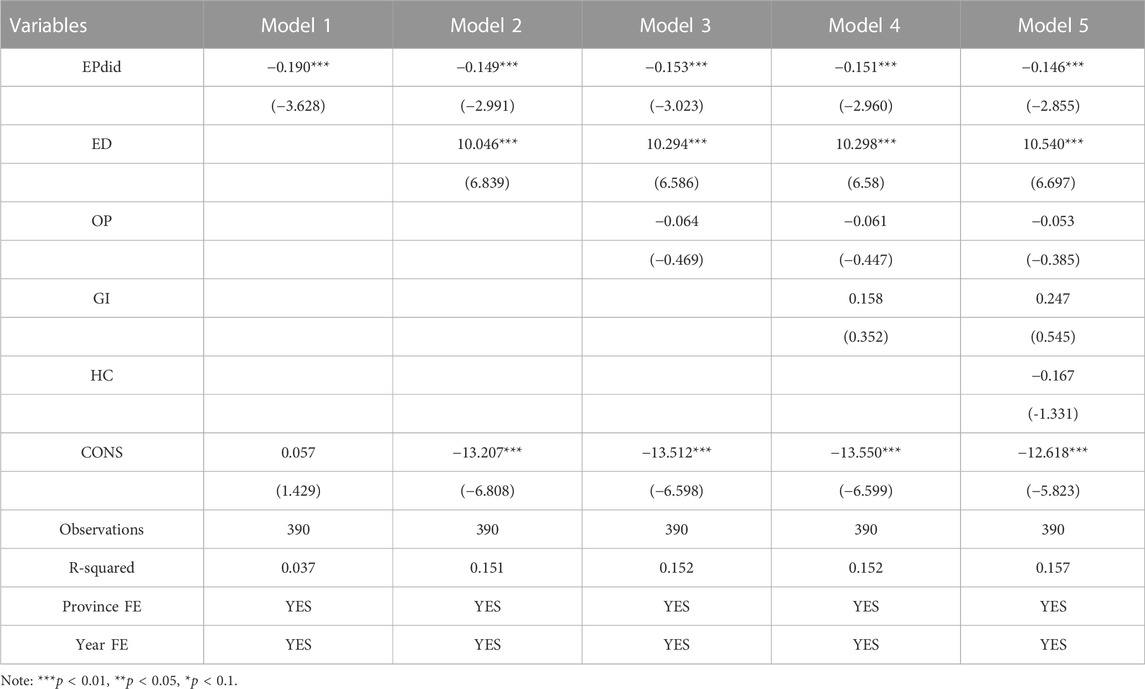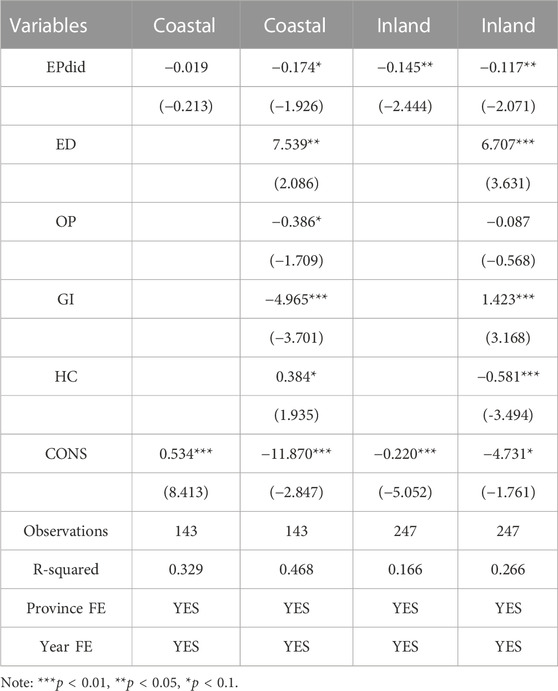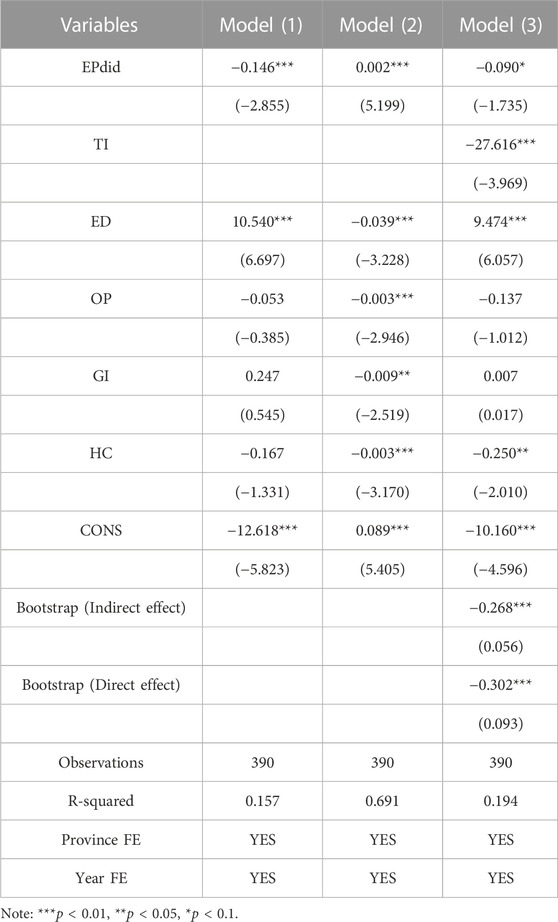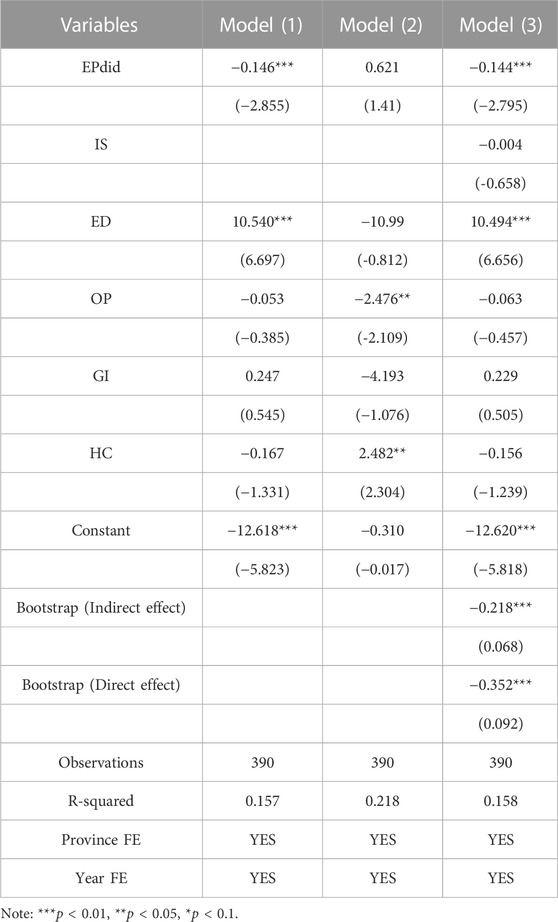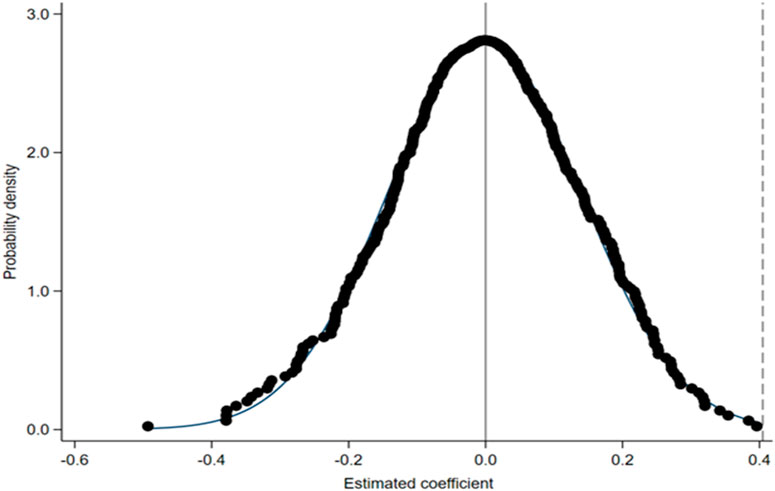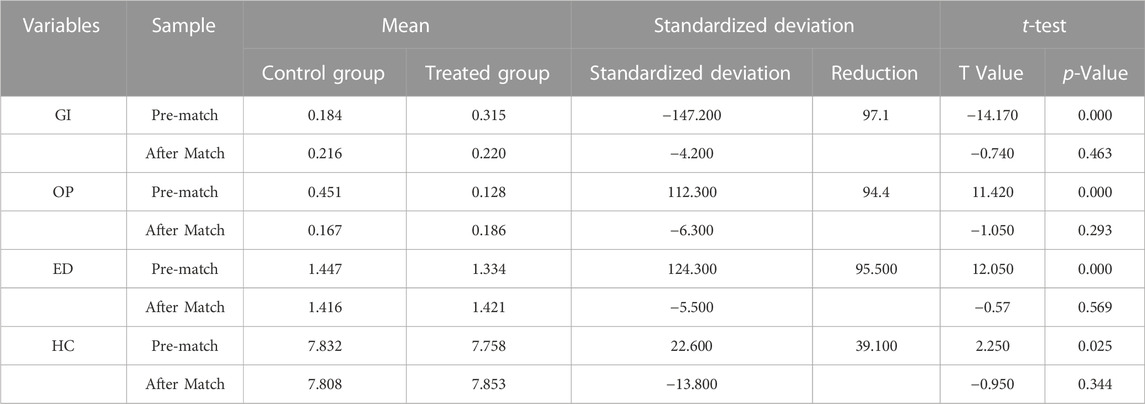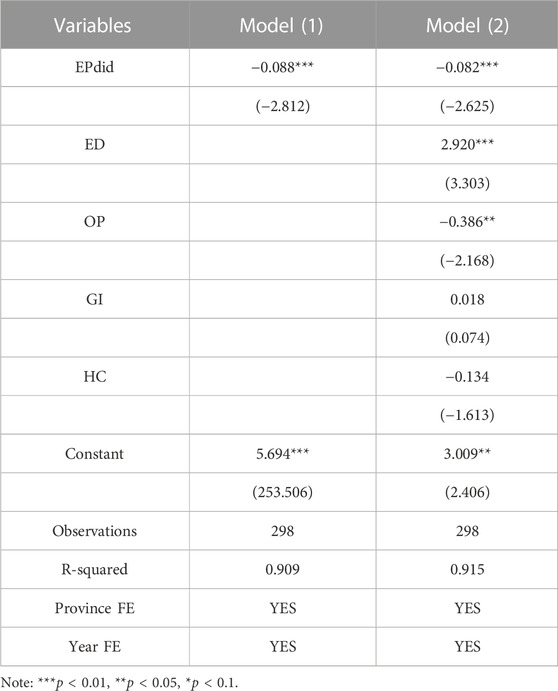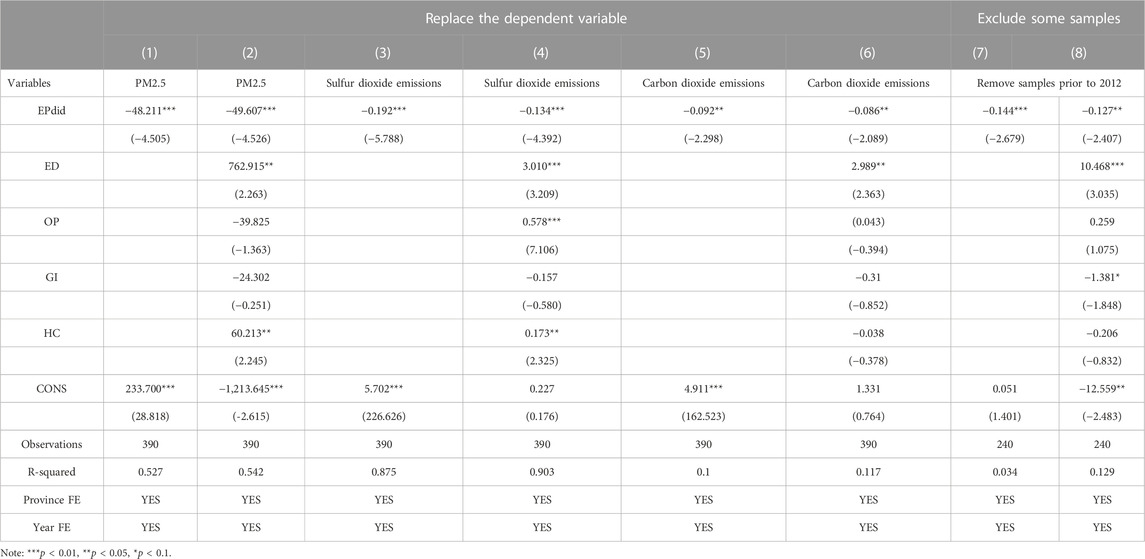- 1Business School, Hohai University, Nanjing, Jiangsu, China
- 2School of Economics and Business Administration, Heilongjiang University, Harbin, Heilongjiang, China
- 3Faculty of Management Engineering, Huaiyin Institute of Technology, Huai’an, Jiangsu, China
The implementation of innovative provinces as a pivotal pilot measure to promote the in-depth advancement of ecology in China is a critical undertaking. An accurate assessment of the environmental effects of these innovative provinces is necessary to obtain a comprehensive understanding of the impact of pilot policies and facilitate the promotion of future policies with precision. In this study, the difference-in-differences method and the mediation model are employed to analyze the effect and mechanism of the pilot policies for innovative provinces on regional environmental pollution in 30 provinces in China from 2008-2020. The results demonstrate that the innovation provincial policies have resulted in an average reduction of 14.6% in environmental pollution annually in the pilot areas. This conclusion is still valid after robustness tests are eliminated. Furthermore, the mediation effect model provides evidence that the innovation provinces pilot policy reduces environmental pollution through technological innovation and industrial structure upgrading. Additionally, the heterogeneity analysis finds that innovation provinces pilot policy have led to a reduction of 17.4% in environmental pollution in coastal regions and a reduction of 11.7% in inland regions annually. Overall, this research contributes to the existing literature by underscoring the importance of innovation-driven development for environmental governance and effectively promoting the construction of a resource-saving and environment-friendly society.
1 Introduction
In recent decades, the global economy has experienced significant growth and development. However, this growth has been accompanied by serious environmental challenges, including rising levels of greenhouse gas emissions, declining air quality, and deteriorating ecosystems. To address these global challenges, innovative development has become an inevitable choice for countries to solve problems related to population, resources, and the environment, and ensure sustainable development (Wang and Luo, 2020). For instance, the United Kingdom has promoted innovative green technologies, such as clean energy applications, to address the haze problem (Foxon et al., 2005). The German government places significant importance on technology development and innovation to achieve energy saving and emission reduction. Since 2005, the energy conservation program has focused on energy efficiency and renewable energy, with the German government supporting the use of renewable energy by establishing large-scale wind and solar power generation facilities to reduce the threat to the environment from energy-intensive and polluting emission resources (Lehr et al., 2008). Similarly, China has highlighted the importance of promoting green development through innovation and promoting the harmonious coexistence of humans and nature at the 20th National Congress of the Communist Party (Dessein et al., 2022). Current research suggests that an increasing number of countries are responding to the deteriorating environmental and climate issues by adopting innovative development approaches.
China has adopted a new development concept that emphasizes innovation, coordination, green growth, openness, and sharing, as part of its broader efforts to establish an ecological civilization system and promote harmonious coexistence between people and nature. The Central Committee of the Communist Party of China (CPC) and the State Council issued the “Outline of National Innovation-driven Development Strategy” in May 2016, which called for the construction of a regional innovation demonstration and leading highland, as well as the establishment of innovative provinces. The implementation of this policy represents a crucial step towards establishing a modern innovation system in China, and aligns with the strategic objective of advancing the nation’s innovation capabilities. At the highest level of policy design, innovation-driven development is recognized as the primary catalyst for achieving high-quality and sustainable economic growth. It is important to note that such growth cannot come at the expense of environmental degradation. Thus, the policy prioritizes pollution prevention and emission reduction as integral components of high-quality economic development.
Innovation development provides new impetus and direction for environmental pollution control (Zhang M. et al., 2022). The role of innovation development in environmental protection has been extensively studied in the literature (Lin et al., 2021). Chiou et al. (2011) used a spatial error model to discuss the impact of innovation on green development, and found that green innovation can significantly promote the improvement of environmental performance. Additionally, Jordaan et al. (2017) found that technological innovation is a key driver in reducing greenhouse gas emissions globally. Moreover, in the field of renewable energy, innovative development can significantly reduce carbon emissions, promote low-carbon economic development, and improve environmental quality (Xu and Lan, 2023). To summarize, numerous prior studies have identified innovation development as a crucial and effective means of mitigating environmental pollution (Ibrahim and Vo, 2021). These findings underscore the significance of innovation in promoting sustainable and high-quality development (Liu et al., 2022).
Despite the abundance of literature on the impact of innovation on environmental pollution, three areas still need to be addressed. First of all, the existing literature on the relationship between innovation development and environmental pollution has primarily focused on direct effects, while mediation effects have been largely neglected. Such as previous research has indicated that innovation has a positive impact on improving the emission standards of industrial enterprises in handling pollutants (Zhang K. et al., 2019), reducing greenhouse gas emissions (Gu and Wang, 2018), and improving the environment (Bhupendra and Sangle, 2015). The extant literature has predominantly centered on examining the direct impacts of innovation, as evidenced by studies conducted by Shahbaz et al. (2018) and Wang and Luo (2020). However, there remains a need for further investigation into the mediating mechanisms through which innovation development can drive environmental protection.
Secondly, while some scholars have delved into exploring the impact of innovation on pollution reduction at the individual level and at the firm level, there is a dearth of research investigating these effects at the macro-level of provinces. For instance, Heidenreich and Kraemer (2015) explicate the micro-individual level by which innovation development can furnish consumers with a wider array of options and facilitate the adoption of environmentally-friendly behaviors, thereby promoting consumer environmental behavior. Additionally, at the meso-firm level, Wang K. L. et al. (2021) and Sahoo et al. (2023) have examined the effect of firm technological innovation on environmental performance. It is important to note that there are clear distinctions between provincial and corporate innovation, individual innovation. The construction of innovative provinces can lead to stronger innovation regional convergence effects (Chen et al., 2020) and regional knowledge spillover effects (Shang et al., 2012). Furthermore, the construction of innovative provinces is a major development decision made at the regional level in China, which can result in a more rational allocation of regional resources and potentially have more significant environmental effects compared to the construction of corporate innovation (Xu et al., 2020). But the impact of innovative province construction on environmental governance remains understudied.
Thirdly, it is worth noting that there is still a lack of research on measuring the extent of the environmental effects of innovation development in developing countries. Research on the relationship between innovation development and pollution reduction has been predominantly conducted in developed countries due to their advanced technology (Ashford, 2002; Popp, 2006). A study focusing on Japan found that the enhancement of technology innovation is conducive to the development of low-carbon technologies, leading to a reduction in carbon emissions and improvement in air quality (Lee and Min, 2015). However, it is noteworthy that developed countries have placed too much emphasis on the role of technological innovation in innovation development and pollution reduction, while neglecting the importance of social and policy innovation (Barykin et al., 2022). Moreover, developed countries have tended to rely too heavily on market mechanisms and have lacked government and social involvement in pollution control (Kvasničková Stanislavská et al., 2023). Studies have found that the dominant role of governments in environmental governance is more pronounced in developing countries than in developed ones, and this government-led environmental governance model can better guarantee the implementation of environmental policies, resulting in more effective improvement of environmental quality (Spilker, 2012; Li et al., 2023). Currently, as the world’s largest developing country, the Chinese government has incorporated innovation development into its national development plan, attempting to use innovation development to break through resource and environmental bottlenecks and achieve a transition to high-quality economic development (Chen et al., 2022). This makes it all the more necessary to use Chinese data to summarize the development patterns in China and provide more references for other developing countries to develop innovation development policy.
Given the research gaps observed above, this research contributes significantly to the existing literature in three ways: Firstly, this study expands the research on the construction of innovative provinces by examining the impact of innovation on environmental governance at the provincial level. By doing so, it attempts to provide further evidence for the study of innovation development and environmental governance at the regional level. Secondly, this study elucidates the mediating mechanisms of environmental governance in pilot policies implemented in innovative provinces through the lenses of endogenous growth theory and ecological economics. It delves into the intricate workings of innovation-driven development, unpacking the “black box” with depth and rigor. Exploring these effects and mechanism can generate new insights into more differentiated and effective decision-making related to innovation development. Finally, this paper utilizes a difference-in-difference (DID) approach to quantitatively assess the environmental effects of innovative provincial policy. This study employs the Difference-in-Differences (DID) model to mitigate pre-test sample discrepancies between the treatment and control groups, thereby eliminating model endogeneity through quadratic differencing. As a result, our analysis provides a more precise assessment of the environmental impacts of innovative provinces.
The subsequent sections of this paper are structured as follows: Section 2 reviews relevant literature, explains the integrated impact of innovative provincial policies on environmental governance; Section 3 explains the econometric model, variable selection, and data sources; The empirical results are introduced in Section 4. Section 5 is the discussion; Finally, the conclusion and policy recommendations are in Section 6. The specific research framework is shown in Figure 1.
2 Policy background and research hypotheses
2.1 Policy background
China has established a strong foundation for the development of innovative provinces, which aligns with the country’s overall strategy of building an innovative and technology-driven economy. The implementation of an innovation-driven development strategy was first proposed at the 18th National Congress of the Communist Party, and has been consistently reinforced and perfected since then. In March 2015, the CPC Central Committee and the State Council issued the “Several Opinions on Deepening the Reform of Institutional Mechanisms to Accelerate the Implementation of the Innovation-Driven Development Strategy,” which aimed to fully realize the innovation-driven development strategy and create a new engine for economic growth. In May 2016, the CPC and the State Council published the “National Innovation-driven Development Outline,” which provided systematic planning and deployment for the implementation of the innovation-driven development strategy in the medium and long term. The construction of innovative provinces then entered a pilot development stage, with Zhejiang, Jiangsu, Sichuan, Guangdong, and other provinces being selected by the central government as pilot regions for this initiative. The Ministry of Science and Technology of China has explicitly stated in the “Guidelines for the Construction of Innovative Provinces” that one of the primary objectives of innovative pilot provinces is to promote “green and low-carbon, harmonious development.” The guidelines highlight that scientific and technological innovation can help solve environmental issues and accelerate the construction of a resource-saving and environment-friendly society.
The policy of constructing innovative provinces is anticipated to have significant implications for China’s economic development and ecological civilization construction. One of the primary benefits of the policy is that it directly improves the level of regional innovation, which is essential for promoting industrial upgrading. Through this policy, the provincial governments are expected to create a conducive environment that fosters innovation and creativity, which in turn will lead to the development of new and improved products and technologies. Furthermore, the emphasis on economic transformation and industrial upgrading in the construction of innovative provinces is expected to promote the development of more energy-efficient and environmentally friendly technologies and products. This is expected to provide new technical means and solutions for environmental protection, thereby contributing to the country’s ecological civilization construction. It is worth noting that an accurate assessment of the environmental effects of innovative provinces is crucial for providing a comprehensive and in-depth understanding of the impact of the pilot policies. This will also facilitate the precise promotion of future policies that are aimed at promoting sustainable development in the pilot provinces and across the country. In conclusion, the pilot construction policy of innovative provinces in China is expected to have significant implications for the country’s economic development and ecological civilization construction. Additionally, the policy’s emphasis on environmental protection and sustainability is expected to provide new technical means and solutions for promoting ecological civilization.
2.2 The effect of construction of innovative provinces on environmental pollution
The core requirement of building an innovative province in China is to promote a development model led by innovation drive, guaranteed by openness to rise and oriented by green development. Theoretically, the construction of innovative provinces can accelerate the pace of innovation and development in pilot provinces, improving the resource utilization efficiency, and supporting the development of energy-saving and environmental protection industry, accelerating the development of the industrial clean technology, and advocating a resource-saving and environment-friendly society and achieve the goal of ecological civilization (Zhao, 2016; Zhang L. et al., 2022). This is not only conducive to exploring a regional development model tailored to local conditions, but also capable of achieving sustainable economic, social and environmental development (Lei et al., 2020; Gao and Yuan, 2021). Specifically, the innovative provinces reduces regional environmental pollution in the following two ways.
On the one hand, the construction of innovative provinces can stimulate enterprises to invest more in new product development, thereby enhancing their innovation capacity (Liao and Li, 2023). This improved innovation capability not only reduces the emission of pollutants such as wastewater, waste gas, and solid waste (Ge, 2019), but also facilitates better management of environmental pollution emissions (Zhang G. et al., 2019), ultimately leading to a reduction in environmental pollution. In addition, Prakash and Potoski (2006) and Bhupendra and Sangle (2015) that innovation can improve the environment through pollution prevention, pollution control, and the use of clean technology in firms Hodson et al. (2018), based on data from the U.S. energy industry, found that an increase in the level of innovation will enable firms to more efficient use of energy while producing less carbon emissions, thereby improving regional air quality.
On the other hand, in order to achieve the goal of building an innovative province, the government will actively increase its investment in the field of green innovation and pool the green innovation elements in each region. Additionally, the government will further promote environmental protection by formulating and implementing environmental regulations and other environmental regulatory actions to restrain the pollutant emissions of enterprises (Waxman and Markey, 2009; Abbass et al., 2022).
H1. Innovative provincial policies has a significant effect on environmental pollution.The construction of innovative provinces represents a notable example of achieving the “win-win” goal of economic development and environmental protection. This policy not only fosters development through innovation but also acknowledges the responsibility of serving as a “demonstration zone” for pollution control. According to Porter’s hypothesis, stimulating the “innovation compensation” effect of enterprises through technological innovation constitutes a critical means of achieving pollution reduction and improving enterprise competitiveness (Porter and Linde, 1995). Furthermore, industrial pollutant emissions significantly decrease with the upgrading of industrial structure, which enhances environmental quality (Wang et al., 2018). Hence, this study proposes a mediating mechanism to elucidate the regional environmental effects of innovative province policies from the perspectives of technology innovation and industrial structure upgrading. Specifically, the policy reduces environmental pollution through the following measures.
2.3 Mediating effect of technology innovation
The development of innovative provinces can play a vital role in improving the local science and technology innovation capacity. One important factor contributing to this improvement is the creation of a favorable environment and adequate conditions for the advancement of science and technology. For instance, the construction of science and technology parks, innovation centers, and research and development institutions, as well as offering higher salaries and improved working conditions for researchers can attract and retain talented researchers. This, in turn, can provide a rich pool of human capital that can enhance the quality of scientific research and technological development (Ponomariov and Boardman, 2010). Additionally, Kuzma et al. (2020) found a positive correlation between better innovation facilities in a region and the number of patents invented by researchers. Furthermore, the construction of innovative provinces can provide strong external incentives for research and development in the area of environmental technology (Borghesi et al., 2015). With these incentives, companies with core technologies and a commitment to environmental innovation may be attracted to enter the region and make breakthroughs in clean energy, environmental equipment, and green manufacturing processes. Finally, the development of innovative provinces will create more opportunities for science and technology exhibitions and forums to promote the exchange and diffusion of scientific and technological information. This will further enhance regional technological innovation capabilities.
Technological innovation is the main driving force to reduce regional environmental pollution. Ehrlich and Holdren (1971) proposed the population, affluence, and technology (PAT) model, which suggest that technological progress can alleviate environmental pollution caused by population growth. Grossman and Krueger (1991) decomposed the factors affecting environmental pollution into scale effects, structural effects, and technology effects and highlighted the important role of technology effects in improving environmental quality. Specifically, this study argues that technological innovation reduces regional pollution in two main ways: On the one hand, defense at the front end of pollution emissions, by improving production levels to reduce pollutant emissions; And on the other hand, strengthening the terminal treatment of pollution, improving the efficiency of pollutant treatment. Improving technology levels can stimulate clean production processes and increase the frequency and scope of clean energy use (Hao et al., 2020). The advanced technology creates clean energy to prevent more pollution (Valentin and Elena, 2020), while improving pollution treatment technology solves the recycling of polluted waste (Wang S. et al., 2021) to achieve the purpose of emission reduction and environmental protection. Specifically, the development of renewable energy sources, new biofuels, and energy-efficient vehicles and appliances will be promoted through the improvement of science and technology guided by innovative development, and these measures will reduce pollutant emissions (Ibrahim and Vo, 2021).
H2. Construction of innovative provinces policy will further reduce environmental pollution through technological innovation.
2.4 Mediating effect of industrial structure upgrading
The development of innovative provinces is a catalyst for the upgrading of the regional industrial structure. Firstly, innovative provinces can upgrade industrial structure by cultivating and attracting high-level talents. According to the innovative talent theory, talent plays a crucial role in driving economic development and industrial upgrading (Cubas et al., 2016). Through the establishment of research institutions and centers, innovative provinces provide a favorable environment for attracting and cultivating high-level talent. Secondly, the construction of innovative provinces can stimulate enterprises’ willingness to innovate and facilitate the transformation of industrial innovation outcomes, thereby promoting industrial structure upgrading (Liao and Li, 2023).
Industrial structure upgrading, with its “structural effect,” is considered an important approach to reducing environmental pollution (Yu and Wang, 2021). The construction of innovative provinces is expected to further this process by promoting the upgrading of both traditional heavy industries and highly polluting industries, as well as the optimization of new industrial structures. On the one hand, provinces will actively promote the transformation and upgrading of industrial structure, and the secondary industries represented by pollution-intensive industries will achieve green transformation of production by choosing clean production application, pollution treatment technology transformation, and direct exit (Bhupendra and Sangle, 2015). On the other hand, the pilot policy has given rise to low-pollution industries represented by modern services and technology-intensive industries, which will lead to an increase in the proportion of tertiary industries and reduce pollution emissions such as waste gas, wastewater, and solid pollution generated during industrial development. Previous studies have found that industrial restructuring can bring about a rational distribution of resources among industries, leading to their full utilization and ultimately reducing environmental pollution (Lind, 2002; Pasche, 2002).
H3. Construction of innovative provinces policy will further reduce environmental pollution through industrial structure upgrading.
3 Methodology and data
3.1 Econometric methodology
In 2018, 14 provinces were selected as pilot areas for innovative provincial policies, providing a quasi-natural experiment for studying the environmental effects of the construction of innovative provincial policies. Specifically, we used the Difference-in-Differences (DID) method to evaluate the environmental performance of the innovative provincial policies (Bertrand et al., 2004; Wang et al., 2019). According to Wooldridge (2007), the fundamental concept behind the DID approach involves measuring the variation in outcomes between a control group and a treatment group both prior to and subsequent to the implementation of a policy, and subsequently generating difference-in-differences statistics that reflect the impact of the policy. The DID method uses the idea of a quasi-natural experiment, which divides the entire sample data into two groups: one group that is affected by the intervention, the treated group, and another group that is not affected by the same intervention, the control group (Conley and Taber, 2011). The DID model is set as follows:
3.2 Variable selection
3.2.1 Environmental pollution
In this study, the “three wastes,” namely, sulfur dioxide emissions, general industrial solid waste generation, and total wastewater discharge, were analyzed dimensionlessly based on the methodology used by Khatun (2009). Principal component analysis was applied to these three variables to obtain weighting coefficients for each region, which were then used to calculate a comprehensive pollution emission index for each year. This index serves as a measure of the regional pollution level for each region.
3.2.2 Construction of innovative province
China put forward the concept of construction of innovative provinces in 2016, and in 2016–2018, 16 provinces (municipalities) have been established as innovative provinces in China one after another. This study characterizes the state of innovative provinces construction in the form of dummy variables. The province is defined as 1 during the pilot year and thereafter; otherwise, the value is 0.
3.2.3 Mediation variables
(1) technology innovation: R&D activities are often considered as one of the important manifestations of the improvement of science. Therefore, this research uses R&D input to measure the level of technology innovation by referring He et al. (2022). The larger the indicator, the higher the level of technology innovation in the region.
(2) Industrial structure upgrading: Drawing on Zhang G. et al.'s (2019) findings, the process of industrial upgrading is typically accompanied by a shift towards the service industry, with the growth rate of the tertiary industry often surpassing that of the secondary industry. In this study, the extent of industrial structure upgrading is measured by the ratio of the value added of the tertiary industry to the value added of the secondary industry, as an increase in this ratio is indicative of industrial structure upgrading.
To avoid the problem of omitted variables in the model that lead to biased regression results, the following variables are included as control variables in the environmental pollution governance model in this paper.
3.2.4 Control Variable
(1) Government intervention
The government can encourage companies to adopt environmental protection measures, and reduce environmental pollution by providing environmental protection subsidies and tax incentives (Pei and Pei, 2022). Referring to the Wang K. L. et al. (2021), Li et al. (2020), the share of government fiscal expenditure in GDP is used to represent the intensity of government intervention in the environment. The higher the share, the stronger the government control, the better it is for reducing environmental pollution.
(2) Openness
The degree of opening up has the following two views on environmental pollution. On the one hand, foreign investment can facilitate the introduction of advanced technology and promote the construction of regional environmental protection facilities, thereby contributing to the reduction of pollution (Letchumanan and Kodama, 2000; Chang, 2012). This phenomenon is often referred to as the “pollution halo” effect. On the other hand, developing countries may lower their environmental regulations in order to attract foreign investment and promote economic development, which may result in them becoming a “pollution haven” (List and Co, 2000; Levinson and Taylor, 2008). This research uses the ratio of foreign direct investment to GDP to measure the level of openness (Wu et al., 2020).
(3) Human capital
Human capital is a composite of various human resources, including education, training, skills, health, knowledge, and experience (Wößmann, 2003). As a crucial factor of production, human capital plays an indispensable role in both regional economic development and environmental pollution control. Research suggests that individuals with higher levels of education tend to exhibit greater awareness of environmental issues and are more inclined to participate in environmental protection behaviors, ultimately leading to a reduction in environmental pollution. Moreover, regions that possess higher levels of human capital tend to foster the development of environmentally friendly and energy-efficient technologies, thus improving regional environmental quality (Lan et al., 2012). Referring to Sarkodie et al. (2020), this research using the logarithms of students enrolled in higher education institutions to measure the regional human capital.
(4) Economic development level
The level of economic development is an important factor affecting environmental pollution. The Environmental Kuznets Curve (EKC) hypothesis suggests an inverse U-shaped trend between economic growth and environmental protection (Grossman and Krueger, 1995). The logarithm of GDP per capita is used to measure economic development in this paper (Hao et al., 2019).
The specific symbols and explanatory notes of each variable are shown in Table 1.
3.3 Data sources
To examine the effects of policies related to innovative province construction on regional environmental pollution management, this paper selects a sample of 30 provinces (excluding Hong Kong, Macao, Taiwan, and Tibet) in China from 2008 to 2020 for empirical analysis. The pilot construction batches and lists of innovative provinces were collected manually from the website of China’s Ministry of Science and Technology and the websites of local governments at each province. Raw data were obtained from the China Statistical Yearbook, China Environmental Yearbook, China Statistical Yearbook and the website of the National Bureau of Statistics. Some data were supplemented according to the provincial (municipal) statistical yearbooks and the statistical bulletins on national economic and social development of the relevant local municipalities. The descriptive statistics and correlation analysis for each variable are shown in Table 2.
Table 2 presents the descriptive statistics and correlation analysis of the main variables. The results indicate that the explanatory variables have a wide range of variation, with the highest value of environmental pollution being 2.200 and the lowest value being −1.562, with a mean value of 0.051, indicating that the degree of environmental pollution varies widely across provinces. On the whole, the correlation between variables is strong, which indicates that the variables selected in this paper are appropriately chosen. In addition, this study used VIF to test for multicollinearity. Previous studies concluded that strong multicollinearity exists when VIF ≥10. As indicated in Table 3, all the variables have VIF values considerably below 10, signifying the absence of multicollinearity among the variables.
4 Empirical results
4.1 Parallel trend test
To verify the validity of the DID method employed in this research, a parallel trend analysis was conducted to assess the trends of pollutant emissions across the sample provinces (refer to Figure 2). Figure 2 shows that the pollutant emission trends of the control and treatment groups exhibited a similar pattern from 2008 to 2017. However, following the implementation of the innovative province policy in 2018, while the pollutant emission trends of the control group remained flat, the treatment group witnessed a marked decline. The parallel trend analysis results suggest that the pollutant emissions of the treatment and control groups were not significantly different before the policy implementation, thereby satisfying the fundamental prerequisite for utilizing the DID method in this research.
4.2 Benchmark regression
This paper use a two-way fixed-effects model to estimate Eq. 1 and analyze the impact of the construction of innovative provinces on regional environmental pollution. The results are shown in Table 4. Model (1) is the regression result without adding control variables, and Model (2)-Model (5) is the result of gradually adding control variables. The results show that in Model (1), the
4.3 Heterogeneity test
The results of the benchmark regression analysis suggest that the implementation of innovative provincial policies has significantly reduced environmental pollution. However, it is important to consider that coastal regions have played a central role in China’s economic development since the reform and opening up. Coastal areas have distinct advantages over inland regions in terms of transportation infrastructure, international trade development, and access to foreign technologies. The Chinese government has implemented relatively liberal foreign trade policies in coastal regions, which has led to a significant divergence in economic development, infrastructure quality, and policy benefits between coastal and inland areas (Su and Jefferson, 2012). Therefore, it is crucial to investigate the impact of innovative province construction policies on environmental pollution under different geographical locations, as the effectiveness of such policies may vary based on regional characteristics. The results of regional heterogeneity are shown in Table 5. In coastal areas, the
4.4 Transmission mechanism test
The abovementioned empirical results show a strong global relationship between innovative provincial policies and environmental pollution. What is the mechanism of the innovative provincial policy to reduce regional pollution? As explained in the previous theoretical analysis, the innovative provincial policy affects the economic development and environmental governance of the regional through technological innovation effects and industrial structure upgrading effects. Ultimately, these effects reduce environmental pollution. This paper draws on Baron and Kenny (1986) and Zhao et al. (2010) to test for mediating effects in three steps. The specific formula is as follows:
Eq. 2 serves as the base model that evaluates the cumulative impact of innovative provincial policies on environmental pollution. Building upon Eq. 2, we have incorporated two distinct mediating variables, resulting in Eqs 3, 4, respectively. Eq. 3 represents the effect of the policy of innovative province construction on the mediating variable
4.4.1 Transmission mechanism test of technological innovation
The transmission mechanism test of technological innovation is shown in Table 6. The total effect of the innovative provincial policy on regional pollution is −0.146 according to the Model (1), thus passing the significance level test of 1%, which is consistent with the previous conclusion. Model (2) is the result of the estimation of the technological innovation of the innovative provincial policy, and the empirical results revealing a significantly positive regression coefficient for the innovative provincial policy at the 1% level. These results suggest that the construction of innovative provinces promotes technology innovation. Model (3) is a regression analysis that explores the relationship between environmental pollution and both pilot policy and technological innovation. The results of Model (3) demonstrate that the coefficient of EPdid is negative and significant at the 10% level, whereas the coefficient of technological innovation is negative and significant at the 1% level. These findings suggest that enhanced technological innovation can effectively reduce environmental pollution. Further analysis by Bootstrap shows that intermediary effect is −0.268, accounting for approximately 47% of the total effect. The bootstrap test are significant at the 1% level, which indicates that technology innovation plays a partially mediating effect in the process of reducing environmental pollution in the construction of innovative provinces. Therefore, H2 is verified.
4.4.2 Transmission mechanism test of industrial structure upgrading
The transmission mechanism test of technological innovation is shown in Table 7.
The results of Model 1 are the same as the analysis above. Model (2) tests the effect of the establishment of innovative provinces on the upgrading of industrial structure, but the results are not significant. Model (3) is a regression analysis that explores the relationship between environmental pollution and both pilot policy and industrial structure upgrading. The results of Model (3) demonstrate that the coefficient of EPdid is negative and significant at the 1% level, and the coefficient of industrial structure upgrading is −0.004, which is not insignificant. It is worth noting that the reason for the insignificant coefficient on industrial structure upgrading may be due to the use of stepwise regression to test for mediating effects, ignoring the “suppressing effects” (Spencer et al., 2005). Therefore, referring to the Zhao et al. (2010), this research use the bootstrap test to test whether there is a mediating effect. According to Eq. 4 and the bootstrap test results show that the coefficients
4.5 Robustness test
4.5.1 Placebo test
To further demonstrate that the decline in regional environmental pollution is attributable to the pilot policy of innovative provinces rather than other policies or incidental factors, this study draws upon the methodology of Chetty et al. (2009) and conducts a placebo test involving 1,000 random replications. As illustrated in Figure 3, the regression coefficients of the random samples cluster around 0 and exhibit a positive t-distribution. Furthermore, all of the regression coefficients exceed the baseline coefficient of −0.4. These findings suggest that the outcomes of this study are not subject to the influence of extraneous variables, and that the reduction in environmental pollution is indeed a result of the innovative province policy. Thus, the results of this research are robust.
5.5.2 PSM-DID test
To mitigate the potential influence of artificial selection bias on the experimental and control groups, this study employed the PSM (propensity score matching)-DID method to conduct robustness tests on the regression results, which are presented in Table 8. The results of the balance test indicate that the standard deviations of the variables significantly decreased after matching, and the p-values corresponding to the t-test of each variable were insignificant, suggesting that there was no significant difference between the treated and control groups after matching. These results signify that the matching process was effective and the PSM-DID method is suitable for robustness testing. Refer to Table 8 for the results of the propensity score matching balance test.
Based on PSM, this research continues to re-estimate Eq. 1 using OLS method and the results are shown in Table 9 below. The findings of Model (2) in Table 9 indicate that the EPdid coefficient is −0.082, which is statistically significant at the 1% level. This result suggests that the implementation of innovative provincial pilot policy can effectively alleviate regional environmental pollution. Notably, the estimated coefficients and significance levels obtained in Table 9 are consistent with those in Table 4, indicating the robustness of the research’s results.
4.5.3 Replace the explanatory variables
This study further replace the explanatory variables to test the robustness. Specififically, raster data on annual average global PM2.5 concentrations, sulfur dioxide emissions, and carbon dioxide emissions from Columbia University were used as robustness indicators, drawing upon prior studies such as Ma et al. (2016), He et al. (2022), and Hanif (2018). The Robustness test are shown in Table 10 from Model (1) to Model (6). The results indicate that the inhibitory effects of innovative provincial policies on PM2.5, Sulfur dioxide emissions and Carbon dioxide emissions are −49.607, −0.134 and −0.086, respectively. Furthermore, these effects are statistically signifificant at the 1% and 5% levels. Thus, the construction of innovative provinces signifificantly reduces the emissions of all three pollutants, further supporting the robustness of the previous fifindings.
4.5.4 Exclude some samples
The results from Model 7 and 8 in Table 10 reveal that after excluding samples prior to 2012, the coeffificient of the innovative province policy is −0.172, and is signifificant at the 5% level, which signifificantly reduces the level of region environmental pollution. No signifificant difference exists between the results of replace the explanatory variables and the exclude some samples. This supports the empirical conclusion that the innovative provincial policies are effective in reducing pollution levels.
5 Discussion
5.1 Discussion for the results of the DID model
China’s policy of constructing innovative provinces is a critical initiative aimed at enhancing regional innovation capacity and promoting China’s position as a leading science and technology nation. The policy has important implications for China’s economic development and ecological construction. This study contributes to a deeper understanding of whether the policy of constructing innovative provinces is conducive to environmental governance, and how the pilot policy affects the regional environment from a macro-perspective. To this end, the study employs the difference-in-difference method and the mediation model to analyze the effect and mechanism of the innovative provinces policy on regional environmental pollution.
Firstly, this research uses the difference in differences (DID) model to examine the impact of innovative provincial policies on regional pollution control. Distinguished from prior research that predominantly adopts regression models (Du et al., 2019; Albitar et al., 2022) and Spatial Econometric Model (Jin et al., 2022; Shi and Zhang, 2022), our study leverages the DID model, which is centered on China’s policy of building innovative provinces. By adopting this approach, our study is able to effectively control for confounding factors that may influence the dependent variable, and also circumvent estimation bias arising from omitted variables that often characterizes fixed effects models (Stuart et al., 2014; Ge et al., 2022).
In addition, this research uncovers a significant positive effect of innovative provincial policies on enhancing regional environmental quality and curbing pollution, as revealed by DID model analysis. Innovation-driven development has emerged as a crucial means of addressing environmental issues, as it stimulates the synergistic development of economic growth and environmental governance through institutional and technological innovation (Ibrahim and Vo, 2021; Abbass et al., 2022). On the one hand, innovation-driven development facilitates the widespread application of novel energy and clean production technologies that can effectively reduce pollutant emissions and optimize resource utilization, thereby creating a mutually beneficial scenario for both environmental governance and economic development (Zhang L. et al., 2022; Jiang, 2022). On the other hand, innovation-driven development also fosters changes in consumption attitudes and behaviors of both businesses and consumers, while heightening public awareness and acceptance of eco-friendly products (Lorenczik and Newiak, 2012).
Moreover, our study reveals significant regional heterogeneity in the effects of innovative provincial policies on environmental governance, with the policy generally having a greater impact in coastal areas than inland areas. We can explain the following aspects. First of all, the coastal region has a larger population and a more developed economy, and consume more fossil energy (Zhao et al., 2018). Thus, the reduction of highly polluting elements through technological innovation and industrial upgrading under the guidance of innovative development is most effective in improving regional environmental quality. Second, from the perspective of human capital, it is evident that coastal regions, with their robust economy and accessible location, attract a greater number of highly educated and skilled scientific and technological professionals (Salike, 2016). This influx of expertise provides vital technical support for the successful implementation of innovative provincial policies, while also expediting the process of policy transformation and execution (Mariz-Pérez et al., 2012). Additionally, compared to their inland counterparts, coastal regions possess more formidable financial resources, thereby enabling greater financial support for pilot policies and yielding a more tangible impact in the realm of environmental pollution control (Fan et al., 2011).
5.2 Discussion for the mediation effect results
Pilot policy for innovative provinces reduce environmental pollution through technological innovation effect and industrial structure upgrading effect respectively.
The research makes a contribution to the endogenous growth theory. Research found that the technological innovation effect of innovative provincial policies comes from the substitution of highly polluting elements by technological progress on the one hand (Zhang L. et al., 2022), and the advancement of clean technologies on the other, which brings good emission reduction effect and improves environmental quality (Abbass et al., 2022). Endogenous growth theory posits that economic growth is achieved not only through technological progress, but more importantly, through technological progress that brings about changes such as clean technologies, so as to better achieve the goal of reducing the environmental pollution (Driessen et al., 2013).
Besides, it is worth noting that industrial structure upgrading has a partially mediating role between innovation and environmental pollution. This study provides new ideas for developing countries to break the environment-economic trap from the perspective of ecological economics. Economic development drives the upgrading of industrial structure and reduces pollutants in the production process, thus achieving sustainable economic growth and environmental protection (Ran et al., 2023). Du et al. (2021) have also highlighted the importance of promoting industrial structure upgrading as a means to reduce environmental pollution, transform the economic development mode, and reconcile the conflict between economic growth and environmental protection.
6 Conclusion ̖policy recommendations and study limitations
6.1 Conclusion
The policy of constructing innovative provinces in China is regarded as a crucial strategy to achieve the coordinated development of the economy and the environment through the application of science, technology, and human innovation. In this regard, this paper use the balanced panel data of 30 provinces in China from 2008 to 2020 and uses the DID model and the mediation effect model to analyze the effect and mechanism of the innovation provinces policy on environmental pollution. Based on this, the heterogeneity of the innovation provinces pilot policy on region environmental pollution is explored. The main findings can be summarized as follows.
First of all, the DID model shows that innovation provinces pilot policy significantly reduces environmental pollution after controlling for other factors and fixed effects. According to the specific findings, the innovation provincial policies have resulted in an average reduction of 14.6% in environmental pollution annually in the pilot areas. This conclusion is still valid after robustness tests are eliminated.
In addition, the mediation effect model shows that the innovation provinces pilot policy reduces environmental pollution through technological innovation and industrial structure upgrading. The findings revealed that the mediating effect contribution rates of technological innovation capability and industrial structure upgrading were 26.8% and 21.8%, respectively. These results respectively imply that a 1% increment in technological innovation capability and industrial structure upgrading in the pilot areas would lead to a reduction in environmental pollution by 0.268% and 0.218%.
Finally, the heterogeneity analysis finds that innovation provinces pilot policy have led to a reduction of 17.4% in environmental pollution in coastal regions and a reduction of 11.7% in inland regions annually. In conclusion, the innovation provinces pilot policy is more effective in coastal areas than inland areas in combating environmental pollution.
6.2 Policy recommendations
On the basis of the above conclusions, this research puts forward the following policy recommendations.
(1) The central government can distill effective measures for implementation, adjustment, and monitoring from the experiences of innovative pilot provinces to serve as a reference for non-pilot provinces. At the same time, the central government should expedite the promotion of innovative provinces, while also taking into account the location conditions, resource characteristics, and economic features of these provinces during the establishment of such pilot programs.
(2) During the construction of innovative provinces, local governments in pilot provinces should increase investment in science education and actively create innovative R&D platforms, to provide a conducive R&D environment for science and technology innovation. Moreover, it is recommended that local governments increase subsidies for enterprise technology innovation, foster the adoption of advanced technologies and clean production processes, optimize resource allocation of high-polluting enterprises using the “catfish effect,” and enhance resource utilization, which in turn reduces pollution emissions.
(3) To enhance the effectiveness of the policy of innovative provinces, the government should prioritize industrial transformation and upgrading. Coastal regions should focus on advancing high-tech industries and upgrading the industrial chain to the middle and high-end segments to foster an eco-friendly industrial structure. Meanwhile, inland areas should phase out obsolete industries and expedite the transformation and upgrading of high energy-consuming and high-polluting industries. Additionally, inland regions should leverage the potential of coastal areas by adopting their technologies, based on their specific developmental needs, to ensure synchronized progress in economic growth and environmental protection across the region.
6.3 Study limitations
This research provides a preliminary exploration of the mechanism between innovation provinces pilot policy and environmental pollution, while two limitations still deserve to be further explored. First, this thesis has systematically explored the mediating role of technological innovation and industrial structure upgrading in the relationships between innovation provinces pilot policy and environmental pollution in China, while the other potential mediation variables such as foreign direct investment (Abbass et al., 2022), resource allocation (Sueyoshi and Yuan, 2015), employment Structure (Xue et al., 2019), regional human capital levels (Wei and Liu, 2022) may also be considered in the further studies which will lead to more useful and practical implications.
Second, this study focuses on the investigation of innovation development policies in developing countries, with China as a representative case. Future research can examine the relationship between innovation development and pollution reduction in developed countries such as the United States, Japan, and the United Kingdom. Exploring the differences between countries can provide a clearer demonstration of the role of government mechanisms in environmental governance (Song et al., 2023). Furthermore, it is essential to note that one of the limitations of the study is the unavailability of these data.
Data availability statement
The raw data supporting the conclusion of this article will be made available by the authors, without undue reservation.
Author contributions
LT: Conceptualization, Formal analysis, writing—original draft, Writing—review and editing and Funding; MT: Software, Methodology and Data analysis; WX (Corresponding author): Writing—review; Data curation and Funding. All authors listed have made a substantial, direct, and intellectual contribution to the work and approved it for publication.
Funding
Doctoral research start-up funding: Z301B20508; This research is funded by the China Scholarship Council.
Conflict of interest
The authors declare that the research was conducted in the absence of any commercial or financial relationships that could be construed as a potential conflict of interest.
Publisher’s note
All claims expressed in this article are solely those of the authors and do not necessarily represent those of their affiliated organizations, or those of the publisher, the editors and the reviewers. Any product that may be evaluated in this article, or claim that may be made by its manufacturer, is not guaranteed or endorsed by the publisher.
References
Abbass, K., Song, H., Mushtaq, Z., and Khan, F. (2022). Does technology innovation matter for environmental pollution? Testing the pollution halo/haven hypothesis for asian countries. Environ. Sci. Pollut. Res. 29 (59), 89753–89771. doi:10.1007/s11356-022-21929-w
Albitar, K., Borgi, H., Khan, M., and Zahra, A. (2022). “Business environmental innovation and CO2 emissions: The moderating role of environmental governance,” in Business strategy and the environment. 3232, 1–12. doi:10.1002/bse.3232
Ashford, N. A. (2002). Government and environmental innovation in europe and north America. Am. Behav. Sci. 45 (9), 1417–1434. doi:10.1177/0002764202045009007
Baron, R. M., and Kenny, D. A. (1986). The moderator–mediator variable distinction in social psychological research: Conceptual, strategic, and statistical considerations. J. personality Soc. Psychol. 51 (6), 1173–1182. doi:10.1037//0022-3514.51.6.1173
Barykin, S., Yadykin, V., Badenko, V., Sergeev, S., Bezborodov, A., Lavskaya, K., et al. (2022). Innovative analysis in climate change: Evidence from developed European countries. Front. Environ. Sci. 10, 1048621. doi:10.3389/fenvs.2022.1048621
Bertrand, M., Duflo, E., and Mullainathan, S. (2004). How much should we trust differences-in-differences estimates? Q. J. Econ. 119 (1), 249–275. doi:10.1162/003355304772839588
Bhupendra, K. V., and Sangle, S. (2015). What drives successful implement tation of pollution prevention and cleaner technology strategy? The role of innovative capability. Environ. Manage 155 (15), 184–192. doi:10.1016/j.jenvman.2015.03.032
Borghesi, S., Cainelli, G., and Mazzanti, M. (2015). Linking emission trading to environmental innovation: Evidence from the Italian manufacturing industry. Res. Policy 44 (3), 669–683. doi:10.1016/j.respol.2014.10.014
Chang, N. (2012). The empirical relationship between openness and environmental pollution in China. J. Environ. Plan. Manag. 55 (6), 783–796. doi:10.1080/09640568.2011.628087
Chen, Q. J., Zhou, W. X., and Pan, J. D. (2020). Evaluation of the process of building a high-level innovative province in Zhejiang: An empirical analysis based on TFP and innovation agglomeration effect in counties and cities. Gov. Res. 36 (5), 88–95. doi:10.15944/j.cnki.33-1010/d.2020.05.010
Chen, F., Wang, M., and Pu, Z. (2022). The impact of technological innovation on air pollution: Firm-level evidence from China. Technol. Forecast. Soc. Change 177, 121521. doi:10.1016/j.techfore.2022.121521
Chetty, R., Looney, A., and Kroft, K. (2009). Salience and taxation: Theory and evidence. Am. Econ. Rev. 99 (4), 1145–1177. doi:10.1257/aer.99.4.1145
Chiou, T. Y., Chan, H. K., Lettice, F., and Chung, S. H. (2011). The influence of greening the suppliers and green innovation on environmental performance and competitive advantage in Taiwan. Transp. Res. Part E Logist. Transp. Rev. 47 (6), 822–836. doi:10.1016/j.tre.2011.05.016
Conley, T. G., and Taber, C. R. (2011). Inference with “difference in differences” with a small number of policy changes. Rev. Econ. Statistics 93 (1), 113–125. doi:10.1162/REST_a_00049
Cubas, G., Ravikumar, B., and Ventura, G. (2016). Talent, labor quality, and economic development. Rev. Econ. Dyn. 21, 160–181. doi:10.1016/j.red.2015.06.004
Dessein, B., Roctus, J., and Biscop, S. (2022). “Xi jinping seeks stability,” in The 20th National Congress of the CCP, Beijing, October 16 -22, 2022.
Driessen, P. H., Hillebrand, B., Kok, R. A., and Verhallen, T. M. (2013). Green new product development: The pivotal role of product greenness. IEEE Trans. Eng. Manag. 60 (2), 315–326. doi:10.1109/TEM.2013.2246792
Du, K., Li, P., and Yan, Z. (2019). Do green technology innovations contribute to carbon dioxide emission reduction? Empirical evidence from patent data. Technol. Forecast. Soc. Change 146, 297–303. doi:10.1016/j.techfore.2019.06.010
Du, K., Cheng, Y., and Yao, X. (2021). Environmental regulation, green technology innovation, and industrial structure upgrading: The road to the green transformation of Chinese cities. Energy Econ. 98, 105247. doi:10.1016/j.eneco.2021.105247
Ehrlich, P. R., and Holdren, J. P. (1971). Impact of population growth. Science 171 (3977), 1212–1217. doi:10.1126/science.171.3977.1212
Fan, S., Kanbur, R., and Zhang, X. (2011). China's regional disparities: Experience and policy. Rev. Dev. Finance 1 (1), 47–56. doi:10.1016/j.rdf.2010.10.001
Foxon, T. J., Gross, R., Chase, A., Howes, J., Arnall, A., and Anderson, D. (2005). UK innovation systems for new and renewable energy technologies: Drivers, barriers and systems failures. Energy policy 33 (16), 2123–2137. doi:10.1016/j.enpol.2004.04.011
Fritz, M. S., Taylor, A. B., and Mackinnon, D. P. (2012). Explanation of two anomalous results in statistical mediation analysis. Multivar. Behav. Res. 47 (1), 61–87. doi:10.1080/00273171.2012.640596
Gao, K., and Yuan, Y. (2021). The effect of innovation-driven development on pollution reduction: Empirical evidence from a quasi-natural experiment in China. Technol. Forecast. Soc. Change 172, 121047. doi:10.1016/j.techfore.2021.121047
Ge, T., Lv, X., Ma, L., and Shen, X. (2022). Can industrial relocation reduce air pollution? Evidence from a quasi-natural experiment in China. Front. Environ. Sci. 584. doi:10.3389/fenvs.2022.910668
Ge, M. (2019). Dynamic relationship between technology innovation of industrial enterprises and environmental pollution: A case study of Zhejiang province. China Nat. Environ. Pollut. Technol. 18 (2), 531–536. doi:10.1177/0958305X18765249
Grossman, G. M., and Krueger, A. B. (1991). Environmental impacts of a North American free trade agreement. National Bureau of Economic Research 11, 3914. doi:10.3386/w3914
Grossman, G. M., and Krueger, A. B. (1995). Economic growth and the environment. Q. J. Econ. 110 (2), 353–377. doi:10.2307/2118443
Gu, G., and Wang, Z. (2018). Research on global carbon abatement driven by R&D investment in the context of INDCs. Energy 148 (1), 662–675. doi:10.1016/j.energy.2018.01.142
Hanif, I. (2018). Impact of fossil fuels energy consumption, energy policies, and urban sprawl on carbon emissions in east asia and the pacific: A panel investigation. Energy Strategy Rev. 21, 16–24. doi:10.1016/j.esr.2018.04.006
Hao, Y., Huang, Z., and Wu, H. (2019). Do carbon emissions and economic growth decouple in China? An empirical analysis based on provincial panel data. Energies 12 (12), 2411. doi:10.3390/en12122411
Hao, Y., Wu, Y., Wu, H., and Ren, S. (2020). How do FDI and technical innovation affect environmental quality? Evidence from China. Environ. Sci. Pollut. Res. 27 (8), 7835–7850. doi:10.1007/s11356-019-07411-0
He, L., Yuan, E., Yang, K., and Tao, D. (2022). Does technology innovation reduce haze pollution? An empirical study based on urban innovation index in China. Environ. Sci. Pollut. Res. 29 (16), 24063–24076. doi:10.1007/s11356-021-17448-9
Heidenreich, S., and Kraemer, T. (2015). Passive innovation resistance: The curse of innovation? Investigating consequences for innovative consumer behavior. J. Econ. Psychol. 51, 134–151. doi:10.1016/j.joep.2015.09.003
Hodson, E. L., Brown, M., Cohen, S., Showalter, S., Wise, M., Wood, F., et al. (2018). US energy sector impacts of technology innovation, fuel price, and electric sector CO2 policy: Results from the EMF 32 model intercomparison study. Energy Econ. 73, 352–370. doi:10.1016/j.eneco.2018.03.027
Ibrahim, M., and Vo, X. V. (2021). Exploring the relationships among innovation, financial sector development and environmental pollution in selected industrialized countries. J. Environ. Manag. 284 (15), 112057. doi:10.1016/j.jenvman.2021.112057
Jiang, L. (2022). Research on the connotation and implementation path of innovation-driven development strategy. Am. J. Industrial Bus. Manag. 12 (2), 145–152. doi:10.4236/ajibm.2022.122010
Jin, S. L., Shun, L., and Qalati, S. A. (2022). Can low-carbon technological innovation reduce haze pollution?-based on spatial econometric analysis. Front. Environ. Sci. 10, 893194. doi:10.3389/fenvs.2022.893194
Khatun, T. (2009). Measuring environmental degradation by using principal component analysis. Environ. Dev. Sustain. 11 (2), 439–457. doi:10.1007/s10668-007-9123-2
Kuzma, E., Padilha, L. S., Sehnem, S., Julkovski, D. J. R., and Rman, D. J. (2020). The relationship between innovation and sustainability: A meta-analytic study. J. Clean. 259 (20), 120745. doi:10.1016/j.jclepro.2020.120745
Kvasničková Stanislavská, L., Pilař, L., Fridrich, M., Kvasnička, R., Pilařová, L., Afsar, B., et al. (2023). Sustainability reports: Differences between developing and developed countries. Front. Environ. Sci. 11, 413. doi:10.3389/fenvs.2023.1085936
Lan, J., Kakinaka, M., and Huang, X. (2012). Foreign direct investment, human capital and environmental pollution in China. Environ. Resour. Econ. 51, 255–275. doi:10.1007/s10640-011-9498-2
Lee, K. H., and Min, B. (2015). Green R&D for eco-innovation and its impact on carbon emissions and firm performance. J. Clean. Prod. 108, 534–542. doi:10.1016/j.jclepro.2015.05.114
Lehr, U., Nitsch, J., Kratzat, M., Lutz, C., and Edler, D. (2008). Renewable energy and employment in Germany. Energy policy 36 (1), 108–117. doi:10.1016/J.ENPOL.2007.09.004
Lei, J., Zhang, Q., and Qi, Y. (2020). Innovation-led development: The logic of China’s economic development. J. Industrial Integration Manag. 5 (01), 1–11. doi:10.1142/S2424862220500013
Letchumanan, R., and Kodama, F. (2000). Reconciling the conflict between the `pollution-haven' hypothesis and an emerging trajectory of international technology transfer. Res. policy 29 (1), 59–79. doi:10.1016/S0048-7333(99)00033-5
Levinson, A., and Taylor, M. S. (2008). Unmasking the pollution haven effect. Int. Econ. Rev. 49 (1), 223–254. doi:10.1111/j.1468-2354.2008.00478.x
Li, J., Shan, Y., Tian, G., and Hao, X. (2020). Labor cost, government intervention, and corporate innovation: Evidence from China. J. Corp. Finance 64, 101668. doi:10.1016/j.jcorpfin.2020.101668
Li, L., Wang, J., Huangfu, X., and Lu, Y. (2023). Frontline governmental cooperation in environmental governance: A case analysis on the ecological demonstration zone in China. Front. Environ. Sci. 11, 458. doi:10.3389/fenvs.2023.1170949
Liao, D. Z., and Li, W. (2023). Does the construction of innovative provinces promote the transformation of industrial innovation results? -Evidence from a pilot quasi-natural experiment on building innovative provinces. Rev. Industrial Econ. 23 (1), 1–15. doi:10.19313/j.cnki.cn10-1223/f.20221128.001
Lin, S., Xiao, L., and Wang, X. (2021). Does air pollution hinder technological innovation in China? A perspective of innovation value chain. J. Clean. Prod. 278, 123326. doi:10.1016/j.jclepro.2020.123326
Lind, M. (2002). An EKC-pattern in historical perspective: Carbon dioxide emissions, technology, fuel prices and growth in Sweden 1870-1997. Ecol. Econ. 42 (1/2), 333–347. doi:10.1016/S0921-8009(02)00108-8
List, J. A., and Co, C. Y. (2000). The effects of environmental regulations on foreign direct investment. J. Environ. Econ. Manag. 40 (1), 1–20. doi:10.1006/jeem.1999.1095
Liu, S., Gao, L., Hu, X., Shi, J., Mohsin, M., and Naseem, S. (2022). Does industrial eco-innovative development and economic growth affect environmental sustainability? New evidence from BRICS countries. Eco-Innovation and green productivity for sustainable production and consumption. Front. Environ. Sci., 323. doi:10.3389/fenvs.2022.955173
Lorenczik, C., and Newiak, M. (2012). Imitation and innovation driven development under imperfect intellectual property rights. Eur. Econ. Rev. 56 (7), 1361–1375. doi:10.1016/j.euroecorev.2012.07.003
Ma, Z., Hu, X., Sayer, A. M., Levy, R., Zhang, Q., Xue, Y., et al. (2016). Satellite-based spatiotemporal trends in PM2.5 concentrations: China, 2004–2013. Environ. health Perspect. 124 (2), 184–192. doi:10.1289/ehp.1409481
Mariz-Pérez, R. M., Teijeiro-Álvarez, M. M., and García-Álvarez, M. T. (2012). The relevance of human capital as a driver for innovation. Cuad. Econ. 35 (98), 68–76. doi:10.1016/S0210-0266(12)70024-9
Pasche, M. (2002). Technical progress, structural change, and the environmental Kuznets curve. Ecol. Econ. 42 (3), 381–389. doi:10.1016/S0921-8009(02)00135-0
Pei, W., and Pei, W. (2022). Empirical study on the impact of government environmental subsidies on environmental performance of heavily polluting enterprises based on the regulating effect of internal control. Int. J. Environ. Res. Public Health 20 (1), 98. doi:10.3390/ijerph20010098
Ponomariov, B. L., and Boardman, P. C. (2010). Influencing scientists’ collaboration and productivity patterns through new institutions: University research centers and scientific and technical human capital. Res. Policy 39 (5), 613–624. doi:10.1016/j.respol.2010.02.013
Popp, D. (2006). International innovation and diffusion of air pollution control technologies: The effects of NOX and SO2 regulation in the US, Japan, and Germany. J. Environ. Econ. Manag. 51 (1), 46–71. doi:10.1016/j.jeem.2005.04.006
Porter, E., and Linde, C. (1995). Toward a new conception of the environment-competitiveness relationship. J. Econ. Perspect. 9 (4), 97–118. doi:10.1257/jep.9.4.97
Prakash, A., and Potoski, M. (2006). Racing to the bottom? Trade, environmental governance, and ISO 14001. Am. J. Political Sci. 50 (2), 350–364. doi:10.1111/j.1540-5907.2006.00188.x
Ran, R., Xie, M., and Hua, L. (2023). How to break the environment-economic trap in rocky desertification contiguous poverty-stricken areas: The mediating effect of industrial structure upgrading. Int. J. Sustain. Dev. World Ecol., 1–15. doi:10.1080/13504509.2023.2169966
Sahoo, S., Kumar, A., and Upadhyay, A. (2023). How do green knowledge management and green technology innovation impact corporate environmental performance? Understanding the role of green knowledge acquisition. Bus. Strategy Environ. 32 (1), 551–569. doi:10.1002/bse.3160
Salike, N. (2016). Role of human capital on regional distribution of FDI in China: New evidences. China Econ. Rev. 37, 66–84. doi:10.1016/j.chieco.2015.11.013
Sarkodie, S. A., Adams, S., Owusu, P. A., Leirvik, T., and Ozturk, I. (2020). Mitigating degradation and emissions in China: The role of environmental sustainability, human capital and renewable energy. Sci. Total Environ. 719, 137530. doi:10.1016/j.scitotenv.2020.137530
Shahbaz, M., Nasir, M. A., and Roubaud, D. (2018). Environmental degradation in France: The effects of FDI, financial development, and energy innovations. Energy Econ. 74 (8), 843–857. doi:10.1016/j.eneco.2018.07.020
Shang, Q., Poon, J. P., and Yue, Q. (2012). The role of regional knowledge spillovers on China's innovation. China Econ. Rev. 23 (4), 1164–1175. doi:10.1016/j.chieco.2012.08.004
Shi, W., and Zhang, L. (2022). Does technological innovation promote haze pollution control? New evidence based on panel threshold model and spatial econometric model. Front. Environ. Sci. 658. doi:10.3389/fenvs.2021.800460
Song, Y., Cheng, Q., Gan, X., and Huang, H. (2023). The dual environmental and economic effects of the emission trading scheme under local fiscal pressure:" efficient markets" and" promising governments. Front. Environ. Sci. 11, 599. doi:10.3389/fenvs.2023.1095321
Spencer, S. J., Zanna, M. P., and Fong, G. T. (2005). Establishing a causal chain: Why experiments are often more effective than mediational analyses in examining psychological processes. J. Personality Soc. Psychol. 89 (6), 845–851. doi:10.1037/0022-3514.89.6.845
Spilker, G. (2012). Helpful organizations: Membership in inter-governmental organizations and environmental quality in developing countries. Br. J. Political Sci. 42 (2), 345–370. doi:10.1017/S0007123411000329
Stuart, E. A., Huskamp, H. A., Duckworth, K., Simmons, J., Song, Z., Chernew, M. E., et al. (2014). Using propensity scores in difference-in-differences models to estimate the effects of a policy change. Health Serv. Outcomes Res. Methodol. 14, 166–182. doi:10.1007/s10742-014-0123-z
Su, J., and Jefferson, G. H. (2012). Differences in returns to FDI between China's coast and interior: One country, two economies? J. Asian Econ. 23 (3), 259–269. doi:10.1016/j.asieco.2010.11.006
Sueyoshi, T., and Yuan, Y. (2015). China's regional sustainability and diversified resource allocation: DEA environmental assessment on economic development and air pollution. Energy Econ. 49, 239–256. doi:10.1016/j.eneco.2015.01.024
Valentin, P., and Elena, C. (2020). The impact of the innovation process on sustainable development strategies and policies. Economica 111, 7–21.
Wang, X., and Luo, Y. (2020). Has technological innovation capability addressed environmental pollution from the dual perspective of FDI quantity and quality? Evidence from China. J. Clean. Prod. 258 (10), 120941. doi:10.1162/003355304772839588
Wang, Z., Jia, H., Xu, T., and Xu, C. (2018). Manufacturing industrial structure and pollutant emission: An empirical study of China. J. Clean. Prod. 197 (1), 462–471. doi:10.1016/j.jclepro.2018.06.092
Wang, H., Chen, Z., Wu, X., and Nie, X. (2019). Can a carbon trading system promote the transformation of a low-carbon economy under the framework of the porter hypothesis?—empirical analysis based on the PSM-DID method. Energy Policy 129, 930–938. doi:10.1016/j.enpol.2019.03.007
Wang, K. L., Zhao, B., Ding, L. L., and Miao, Z. (2021). Government intervention, market development, and pollution emission efficiency: Evidence from China. Sci. Total Environ. 757, 143738. doi:10.1016/j.scitotenv.2020.143738
Wang, S., He, Y., and Song, M. (2021). Global value chains, technological progress, and environmental pollution: Inequality towards developing countries. J. Environ. Manag. 277 (1), 110999. doi:10.1016/j.jenvman.2020.110999
Waxman, H. A., and Markey, E. J. (2009). American clean energy and security act of 2009. Washington: US House of Representatives, 111–137.
Wei, L. Y., and Liu, Z. (2022). Air pollution and innovation performance of Chinese cities: Human capital and labour cost perspective. Environ. Sci. Pollut. Res. 29 (45), 67997–68015. doi:10.1007/s11356-022-20628-w
Wen, Z. L., and Ye, B. J. (2014). Analyses of mediating effects: The development of methods and models. Adv. Psychol. Sci. 22 (5), 731–745. doi:10.3724/SP.J.1042.2014.00731
Wooldridge, J. (2007). What’s new in econometrics? Lecture 10 difference-in-differences estimation. NBER Summer Institute. Available at: www. nber. org/WNE/Slides7–31–07/slides_10_diffindiffs.
Wößmann, L. (2003). Specifying human capital. J. Econ. Surv. 17 (3), 239–270. doi:10.1111/1467-6419.00195
Wu, H., Ren, S., Yan, G., and Hao, Y. (2020). Does China's outward direct investment improve green total factor productivity in the “belt and road” countries? Evidence from dynamic threshold panel model analysis. J. Environ. Manag. 275, 111295. doi:10.1016/j.jenvman.2020.111295
Xu, D., and Lan, Q. (2023). How does education affect urban carbon emission efficiency under the strategy of scientific and technological innovation? Front. Environ. Sci. 11, 489. doi:10.3389/fenvs.2023.1137570
Xu, N., Hong, Y., and Liu, Z. (2020). The construction of an innovative province and the exploration of Jiangsu. Zhenjiang: Nanjing University Press.
Xue, J., Ji, X., Zhao, L., Yang, Y., Xie, Y., Li, D., et al. (2019). Cooperative econometric model for regional air pollution control with the additional goal of promoting employment. J. Clean. Prod. 237, 117814. doi:10.1016/j.jclepro.2019.117814
Yu, X., and Wang, P. (2021). Economic effects analysis of environmental regulation policy in the process of industrial structure upgrading: Evidence from Chinese provincial panel data. Sci. Total Environ. 753 (20), 142004. doi:10.1016/j.scitotenv.2020.142004
Zhang, G., Zhang, P., Zhang, Z. G., and Li, J. (2019). Impact of environmental regulations on industrial structure upgrading: An empirical study on Beijing-Tianjin-Hebei region in China. J. Clean. Prod. 238 (20), 117848. doi:10.1016/j.jclepro.2019.117848
Zhang, K., Jiang, W., Zhang, S., Xu, Y., and Liu, W. (2019). The impact of differentiated technological innovation efficiencies of industrial enterprises on the local emissions of environmental pollutants in Anhui province, China, from 2012 to 2016. Environ. Sci. Pollut. Res. 26 (27), 27953–27970. doi:10.1007/s11356-019-06032-x
Zhang, L., Mu, R., Hu, S., Yu, J., and Zhang, J. (2022). Industrial coagglomeration, technological innovation, and environmental pollution in China: Life-cycle perspective of coagglomeration. J. Clean. Prod. 362 (15), 132280. doi:10.1016/j.jclepro.2022.132280
Zhang, M., Yan, T., and Ren, Q. (2022). Does innovative development drive green economic growth in resource-based cities? Evidence from China. Front. Environ. Sci. 9, 745498. doi:10.3389/fenvs.2021.745498
Zhao, X., Lynch, J. G., and Chen, Q. (2010). Reconsidering Baron and Kenny: Myths and truths about mediation analysis. J. Consumer Res. 37 (2), 197–206. doi:10.1086/651257
Zhao, D., Chen, H., Li, X., and Ma, X. (2018). Air pollution and its influential factors in China’s hot spots. J. Clean. Prod. 185 (1), 619–627. doi:10.1016/j.jclepro.2018.02.181
Keywords: innovative provinces, industrial structure upgrade, environmental pollution, quasi-natural experiment, DID model
Citation: Tang L, Tang M and Xi W (2023) Has building innovative provinces reduce environmental pollution?--evidence from a quasi-natural experiment in China. Front. Environ. Sci. 11:1177478. doi: 10.3389/fenvs.2023.1177478
Received: 01 March 2023; Accepted: 15 May 2023;
Published: 23 May 2023.
Edited by:
Ashfaq Ahmad Shah, Hohai University, ChinaReviewed by:
Gal Hochman, Rutgers, The State University of New Jersey, United StatesBaogui Xin, Shandong University of Science and Technology, China
Copyright © 2023 Tang, Tang and Xi. This is an open-access article distributed under the terms of the Creative Commons Attribution License (CC BY). The use, distribution or reproduction in other forums is permitted, provided the original author(s) and the copyright owner(s) are credited and that the original publication in this journal is cited, in accordance with accepted academic practice. No use, distribution or reproduction is permitted which does not comply with these terms.
*Correspondence: Wenjia Xi, eGl3ZW5qaWFAaHlpdC5lZHUuY24=
 Lu Tang
Lu Tang Mengcong Tang
Mengcong Tang Wenjia Xi
Wenjia Xi
